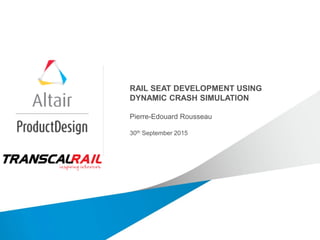Rail Seat Development using Dynamic Crash Simulation
Developing and validating a crashworthy rail seat to a contracted rail standard represents a real challenge: The seat has to be designed so that it is strong enough to withstand the load of occupants under a high acceleration into the seat structure, but soft enough to not cause serious injuries to an occupant impacting the seat from a neighbouring row of seats. It usually involves a high number of time consuming and costly physical tests. Transcal Rail together with Altair ProductDesign UK applied advanced Finite Element (FE) analysis, using Radioss HyperWorks, to develop and optimise the seat design to meet structural requirements and record injuries from fully representative instrumented dummy models. The physical test set up is virtually replicated including correct dummy positioning and specifying the sled pulse curve as a prescribed motion. Crucially, it can be done prior to any materials being ordered or tools manufactured thus potentially eliminating a complete prototype testing phase altogether. The FE model can be created with various degrees of complexity depending on the amount of available data defining the original design. This initial investment in creating a representative model will bear fruit in the ability to quickly highlight pitfalls, manage design updates and perform “what-if” studies during the development phase. This enables the structure to evolve into an efficient and robust design while significantly increasing confidence levels to pass the final validation physical test. Speakers Pierre-Edouard Rousseau, Altair, on behalf of Transcal Rail

Recommended
Recommended
More Related Content
What's hot
What's hot (6)
Viewers also liked
Viewers also liked (6)
Similar to Rail Seat Development using Dynamic Crash Simulation
Similar to Rail Seat Development using Dynamic Crash Simulation (20)
More from Altair
More from Altair (20)
Recently uploaded
Recently uploaded (20)
Rail Seat Development using Dynamic Crash Simulation
- 1. RAIL SEAT DEVELOPMENT USING DYNAMIC CRASH SIMULATION Pierre-Edouard Rousseau 30th September 2015
- 2. Copyright © 2013 Altair Engineering, Inc. Proprietary and Confidential. All rights reserved. Introduction
- 3. Copyright © 2013 Altair Engineering, Inc. Proprietary and Confidential. All rights reserved. Mesh creation Dummy positioning & Instrumentation FEA process CAD import Loadcase setup Model Build Post-processing
- 4. Copyright © 2013 Altair Engineering, Inc. Proprietary and Confidential. All rights reserved. Test/Simulation loadcase
- 5. Copyright © 2013 Altair Engineering, Inc. Proprietary and Confidential. All rights reserved. Dummy models
- 6. Copyright © 2013 Altair Engineering, Inc. Proprietary and Confidential. All rights reserved. Sled pulse
- 7. Copyright © 2013 Altair Engineering, Inc. Proprietary and Confidential. All rights reserved. Test example
- 8. Copyright © 2013 Altair Engineering, Inc. Proprietary and Confidential. All rights reserved. Safety forward event
- 9. Copyright © 2013 Altair Engineering, Inc. Proprietary and Confidential. All rights reserved. Injury post processing Injury Criteria GM/RT2 100 issue5 Injury Criteria GM/RT2100 issue5 Head Resultant Acceleration 80g (3ms) Chest deflection 63mm Head Injury criteria 500 (HIC15) Chest V*C 1.0 ms-1 Neck Bending moment Flexion 310Nm Femur Peak Force LH & RH 5.7kN (4.0kN for TI >1.0) Neck Bending Moment Extension -135Nm Knee Displacement LH &RH 16mm Neck Injury Criteria (NIJ) 1 Tibia Index Up/Low LH & RH 1.0 (1.3 for FL <4.0kN) Chest Acceleration 60g (3ms) Tibia Axial Load LH & RH 8.0kN
- 10. Copyright © 2013 Altair Engineering, Inc. Proprietary and Confidential. All rights reserved. Injury post processing
- 11. Copyright © 2013 Altair Engineering, Inc. Proprietary and Confidential. All rights reserved. Injury post processing
- 12. Copyright © 2013 Altair Engineering, Inc. Proprietary and Confidential. All rights reserved. Integrity rearward event
- 13. Copyright © 2013 Altair Engineering, Inc. Proprietary and Confidential. All rights reserved. Integrity post processing
- 14. Copyright © 2013 Altair Engineering, Inc. Proprietary and Confidential. All rights reserved. Concept design Baseline simulation for each loadcase Design changes discussed with customer Engineered feasible SolutionUpdated CAD Updated FE Model Iterative Simulations to Improve Performance Optimisation
- 15. Copyright © 2013 Altair Engineering, Inc. Proprietary and Confidential. All rights reserved. Simulation driven design benefits Offers a time and cost effective solution compared to prototype build and physical testing. FE model with various possible degrees of complexity. Allows detailed interrogation of results not normally possible with physical testing. High number of iterations possible due to short simulation time. Quick feedback on alternative solution possible. Possible implementation early in the engineering process. No need to « re-test » for sign-off if small changes are later implemented. High level of confidence before sign-off with physical testing.
- 16. Thank you for your attention
